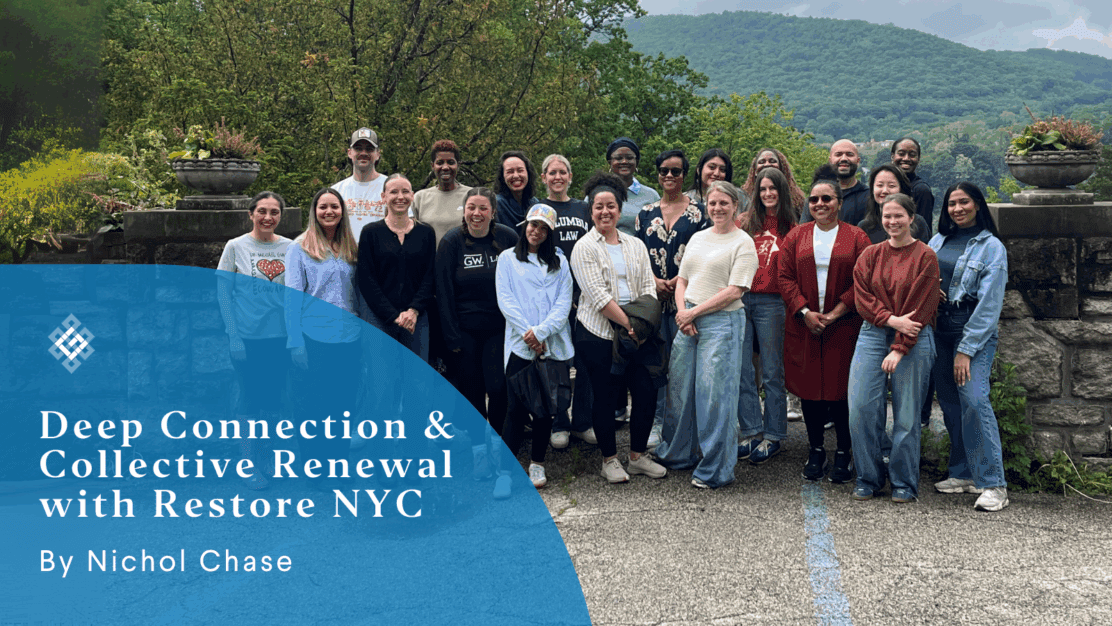Deep Connection and Collective Renewal with Restore NYC
By Nichol Chase
In May, I co-led a retreat that was part of a larger initiative through the Garrison Institute’s Contemplative-Based Resilience (CBR) program to support the staff of Restore NYC. This extraordinary organization stewards powerful, trauma-informed work serving survivors of trafficking and exploitation.
I am still deeply moved by my time with the Restore team – filled with lasting inspiration, profound gratitude for their vital work, and a deep sense of honor to have offered support. In thinking about them and their courage, my mind keeps coming back to these words by Mahatma Ghandi: “The best way to find yourself is to lose yourself in the service of others.”
I had the great joy of collaborating with Isabel Sáez, a wise and compassionate faculty member of the CBR team, on this daylong retreat. It was an easeful and generative partnership that brought together our shared commitment to holding space for healing, reflection, and community.
For many on the Restore team, this was their first visit to the Garrison Institute. We spoke about its past as a Capuchin monastery, its present-day role as a center for contemplative practice, thought, and action, and how Jonathan and Diana Rose helped found the current iteration of the Institute. We also acknowledged the Indigenous lands on which the Institute rests and the deeper histories held in the land itself.
We began our retreat in the meditation hall with a morning welcome circle, where each person shared what they were bringing into the space and what they hoped to receive from the day. This opening reflection created a sense of presence and shared intention that carried through everything that followed.
After the welcome, I guided the group through a long-form contemplative embodied practice—a grounding and integrative experience that introduced many of the core tools we use in CBR.
We engaged in calming strategies like swaying, bilateral stimulation, and shaking, warmed up the joints, moved through gentle somatic sequences, and explored a rich array of breath practices. These practices helped soothe the nervous system and created a grounded foundation for the rest of our time together.
Our lunchtime together was filled with nourishing food and conversation – an easy unfolding of stories, laughter, and truth. As we continued to connect, we shared openly about our lives and the work that calls us, held together by passion, levity, and the kind of honest communication that leaves you both grounded and uplifted.
In the afternoon session, we stepped outdoors for mindful walking in nature. Though the ground was damp with spring rain, the lush trees and gentle air invited a deeper attunement to the land and to ourselves. Walking silently in community allowed the team to process the morning and arrive more fully in their bodies.
Following that, Isabel Saez led a micro-lab on connection and communication, guiding participants through reflective prompts such as:
- What’s a memory that brings you joy or laughter—where were you, who were you with, and what were you doing?
- What’s one gift you bring to a group that others might not always see?
- What’s the story of your name or your community?
The energy in the room became more vibrant and open as people shared, listened, and connected on a more personal level.
After the micro-lab, we moved into a brief qualitative survey to gather reflections and insights from the team. The survey was followed by a creative session, where each person made a simple creative artifact to symbolize something they were taking with them from the retreat – some wrote poems, created symbols accompanied by meaningful words, or drew scenes of what they saw in nature.
These creative expressions became the inspiration for our final closing circle, where participants shared a single “gold nugget”—a key insight or feeling they were carrying forward.
The day came to a gentle and beautiful close as I guided several participants down the walking path to New York’s Hudson Line train. As we walked beneath canopies of vibrant trees, we spoke softly, carried by the stillness and integration of the day. One by one, they boarded the train back to New York City, and I waved a warmhearted goodbye as the train made its way down the tracks.
Throughout the day, I was continually moved by the resilience, authenticity, and generosity of the Restore team. Their work is profound—and the toll it can take is also profound. This retreat was a rare chance to exhale, to reflect, and to be in community.
This gathering was part of a broader arc in our work with Restore: from initial assessment and listening to this retreat, and now into a new phase of coaching, an online course, and the creation of a self-care guide tailored for their unique context.
Deep gratitude to Isabel Sáez for her co-leadership, and to the entire Restore team—especially Beck, Lenore, and Tameika—for their vision, openness, and care.
We at CBR are passionate about serving those who serve the most vulnerable — the caregivers, frontline workers, and changemakers who show up day after day in the face of immense challenges. This service is the very heart of the CBR Program.
We recognize that this work isn’t easy. It demands strength, compassion, and endurance. That’s why we’re here. CBR offers the tools, space, and support to sustain those doing the hardest work. We teach practices that ground, heal, and renew, because when helpers are well-resourced, their impact deepens — and their care becomes more sustainable.
This is the work that moves us. The work that inspires and sustains us. We help the helpers — so they can keep healing the world.
Learn more about the CBR initiative and team.
Nichol Chase, E-RYT 500, TSM, BM, serves as CBR’s Experiential Education Advisor for Special Projects.
